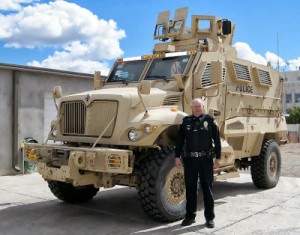In Caldwell, Idaho, a SWAT team was deployed on August 12 in an effort to apprehend a single suspected gang member, who escaped and was subsequently arrested through less dramatic means.
Caldwell, as some might recall, was the scene of a SWAT-style midnight raid carried out in February 2013 in which the residents of an entire apartment complex were terrorized by officers carrying out a supposed “welfare check.” The raiders kicked in two doors before finding the man they were after, who had been accused of posting a “threatening” image on Facebook after having an argument with a woman.
Six days after the most recent SWAT raid in Caldwell, police in Boise dispatched a SWAT team in an MRAP – a combat-grade armed vehicle – to arrest a man suspected of pointing a gun at a pedestrian. This raid, which took place late in the evening, resulted in an arrest on a single misdemeanor charge of disturbing the peace, which is the sort of thing that happens when police carry out a military-style raid at midnight.
Neither of those arrests required the use of a SWAT team and military hardware, which were used because of availability, not need. Since 2011, reports the Idaho Statesman, police agencies in Idaho have received more than $9.3 million in military equipment from the federal government. This includes MRAP combat vehicles, which have been given to police departments in Boise, Nampa, Caldwell, Pocatello, Post Falls, and Preston.
The last city on that roster of those “blessed” with an MRAP, Preston, is a tranquil community of about 5,000 people near the Utah border where crime is practically unknown. Last October I interviewed Chief Ken Geddes, who was prickly and defensive, invoking the Sandy Hook massacre and the ubiquitous threat of terrorism to justify the acquisition of a military assault vehicle.
For its part, the Statesman couldn’t persuade Chief Geddes to speak on the record about his department’s expensive new toy — for which a use will have to be found very soon, if Chief Geddes wants to keep it.
Analyst Noel Brinkerhoff points out that the Pentagon’s 1033 program specifies that “any participating law enforcement agency must use its equipment within one year of receiving it. If they don’t, they have to give it up.”
If a police department wants combat gear, it can get it, and once the department has that gear, it will use it. In fact, the Feds will require that they invent a “need” where none exists. This helps explain why routine police calls are now treated as potential military engagements.
12:09 pm on August 27, 2014





